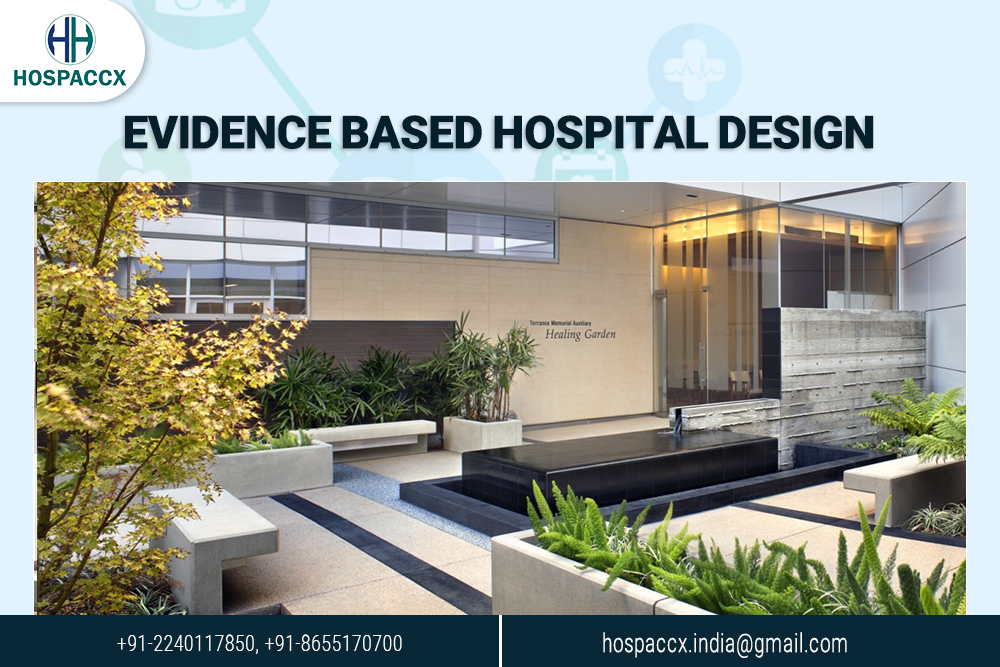INTRODUCTION
Evidence-based design (EBD) has become the fastest-growing trend in healthcare development. It is a scientific analysis methodology that emphasises the use of data acquired in order to influence the design process in hospitals. It measures the physical and psychological effects of the built environment on its users. EBD uses the formularization of hypothesis, testing/analyzing and outcome gathering as a framework.
Considering the above facts, Hospaccx teamwork on the market trends and dynamic of evidence-based hospital design. This is macroficial study of Evidence-Based Hospital Design if you want to get into more detail you can contact info@hhbc.in
HISTORY OF EVIDENCE BASED DESIGN
| 1972 | Evidence-based movement started |
| 1985 | First Planetree Model Hospital |
| 1993 | The Centre for Health Design |
| 2000 | Pebble Project |
| 2004 | 600+ studies that provides evidence |
| 2005 | The Fable Hospital |
| 2008 | EDAC certification |
| 2008 | 1200+ studies that provides evidence |
| 2009 | 100 individuals received EDAC certification |
8 STEP PROCESS TO APPROACH EVIDENCE-BASED HOSPITAL DESIGN
- Define EBD goals & objectives : The overall goal might be related to the buildings’ purpose and its functionality within the community. Reducing patient and staff stress, improving safety and quality and increasing operational efficiency should also be relevant goals.
- Find sources for relevant evidence : A good place to start to look is through ‘research journals’ or on ‘dedicated health design or EBD sites’. Also, check out e-books on Healthcare design.
- Critically interpret relevant evidence : Make sure the findings are the outcome of repeatable and reputable scientific methods. Avoid findings that do not provide a source of their findings and the statistical details and methods that were used for the study.
- Create and innovate EBD concepts : Play with what has been done and explore how going a step further could be beneficial for your project.
- Develop a hypothesis : Use existing knowledge and build on it.
- Collect baseline performance measures : Where available use existing data from a building before refurbishment or from comparable health facilities as a baseline performance measure.
- Monitor implementation of design and construction : The project team is responsible for monitoring the implementation of the EBD interventions during the construction phase and has to make sure that the defined goals and objectives will not be compromised. Any alternate design solutions that might be suggested for cost reasons, should always take into account the impact on the project outcome. Any actual design changes should be documented and potential impacts on the project outcomes should be pointed out and captured.
- Measure post occupancy performance results : Measure levels or changes in noise, light, traffic, aesthetics, staff satisfaction, patient healing rate, average bed occupancy rates etc. to evaluate key performance indicators.
CRITICAL THINGS FOR EVIDENCE- BASED HOSPITAL DESIGN
There are three critical things can be incorporated for EBD in your hospital or clinic facility decisions:
- Identify important metrics
- Engage stakeholders early in the process
- Partner with the right, collaborative team
BENEFITS OF EVIDENCE- BASED HOSPITAL DESIGN
- Saves Time
Incorporating research-based best practices into decision making creates efficiency in the process by streamlining the set of options based on research. Users and stakeholders spend less time in meetings and more time on their full time jobs. Everyone else moves through the process faster as well, keeping the project schedule on time. - Improves the Design Process
EBD helps the team quickly and clearly define goals and criteria, improve the multi-disciplinary team coordination and create more time to unlock specific design opportunities. - Avoids Risk
Understanding how to apply best practices in healthcare design reduces the risk of a bad decision. - Improves Operations
EBD impacts workflow, safety, and patient and staff satisfaction—all important factors to overall success of operations.
LIMITATIONS OF EVIDENCE- BASED DESIGN
- The knowledge domains of EBD for healthcare facilities remain narrow and rigid.
- If held tight by its EBD proponents this position may soon stifle healthcare design research and practice for a lack of flexibility and inclusivity.
- EBD also include the fact that its proponents encourage ‘quantitative’ research more than ‘qualitative’ research ignoring the fact that qualitative research has been an important mode of knowledge generation for centuries.
CONCLUSION
The state of knowledge of evidence-based healthcare design has grown rapidly in recent years. The Evidence-Based Design movement is producing design recommendations based on causal relationships between features of the designed healthcare environment and desired outcomes. The evidence indicates that well-designed physical settings play an important role in making hospitals safer and more healing for patients, and better places for staff to work.
Are you planning to design your healthcare organisation? We can help you to design your dream project, below are the healthcare design services that we offer:-
- Healthcare Architecture Design services
- MEP Design
- Landscape Design services
- Structural Design services
- Interior Design services
It is the superficial and macro level study for more details kindly contact Hospaccx Healthcare business consulting Pvt. ltd at hospaccx.india@gmail.com Or you can visit our website on hospaccxconsulting.com
Related Team Members




















